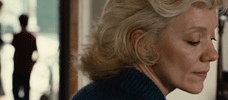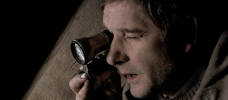Reviews
Tiro en la cabeza
Jaime Rosales
Spain/France, 2008
Credits
Review by Evan Kindley
Posted on 19 October 2008
Source 35mm print
Categories The 46th New York Film Festival
The screening of Jaime Rosales’ Bullet in the Head that I attended at the New York Film Festival began with a couple of warnings about what to expect. The sound had been malfunctioning during an introductory advertisement for the festival, and both the director and the programmer wanted to reassure us that what we would be hearing in the film about to be shown was not due to a technical problem. “The sound in my film is pretty peculiar,” Rosales told the audience, promising us that whatever we might think was wrong wasn’t.
Thus was removed one of the few surprises awaiting viewers of Bullet in the Head: we braced ourselves for something unusual, and we got it. The sound design of the film is, indeed, peculiar. There’s virtually no dialogue (two words are spoken towards the end) and almost all the sound we hear is ambient: traffic noise, birdsong, background chatter. The film is shot like surveillance footage, recording the movements of an unnamed man around the Spanish city of San Sebastian.
Everything is observed from a distance, often from the other side of some kind of mediating screen, often a window or a glass door. We watch the man, played by Ion Arretxe - who also served as production designer on the film, and who rather resembles a more put-together Slavoj Zizek - browse at a newsstand, converse with friends at a playground and a café, goes to a party, shops for records, et cetera. We are not given the slightest clue about his identity or his profession; he seems to have an awful lot of leisure time, so he could be a writer or independently wealthy; or, then again, it could be the weekend. A lot of time is allowed for every reviewer to make their own conjectures, since every scene is composed of a single take, usually with minimal camera movement, and they last an average of ten minutes or so. Only very late in the film does any intrigue develop, as he and some associates travel to France shadowed by what are eventually revealed to be police detectives. The man and his associates confront the police, kill them, and escape.
If this sounds very boring, I have done my job. I won’t say there aren’t moments of meditative aesthetic interest, or a couple of witty juxtapositions (as when Rosales cuts from a developing sex scene to a shot of an ATM), but for the most part the film gives the impression of being virtually undirected. It lacks the countercultural daring of Andy Warhol’s similar experiments in cinematic minimalism, often feeling like rushes from a second A.D. unit rather than an actual film (even an avant-garde one).
It’s too bad that the film is such a wash, because Bullet in the Head, in attempting to blend the aleatory techniques of the avant-garde with the tension-building techniques of a typical thriller, is trying for a synthesis that’s potentially pretty exciting. The idea, after all, isn’t totally unprecedented - think of the last shot of Michael Haneke’s Caché or, well before that, Francis Ford Coppola’s The Conversation - but no one’s ever extended it for the length of an entire film before. The failure of Rosales’ film suggests why, but it doesn’t follow that no one should ever try again.
Still, on its own terms Bullet in the Head fails resolutely. At the New York Film Festival screening, Rosales stated that he wanted to make a film about terrorism that was divorced from the ideology that usually accompanies such images, in order to get viewers to think about the issue in a new way. (The film was suggested by the murder of two Spanish police officers by members of a Basque Separatist group in 2007.) This intention, interesting in itself, would ironically be a lot more subversive if Bullet in the Head were closer in structure to a conventional thriller: if we saw multiple incidents of violence from a distance, without being able to hear the dialogue in the scenes that explain why the violence is happening, maybe we would be moved to reconsider the reality of terrorism, and the genre of the action movie, and the ideologies that link them.
But by building up to a single climactic killing, Rosales ensures that his film will be both extraordinarily dull and critically feeble. Informed by the unsubtle (and unoriginal) title that somebody’s going to get shot somewhere along the line, you spend the whole movie waiting for the proverbial last act. Rather than stripping meaning or ideology away from familiar images of violence, Bullet in the Head overdetermines its every frame, playing an extremely perverse zero-sum game with its audience: either the guy gets it in the head in this scene or he doesn’t. In fact, far from deconstructing terrorism, Rosales’ film operates according to a kind of terroristic logic itself. It really only has one trick up its sleeve: the possibility of blowing itself apart.
More The 46th New York Film Festival
-

Wendy and Lucy
2008 -

The Northern Land
2008 -

The Last Command
1928 -

Hunger
2008 -

Lola Montès
1955 -

Summer Hours
2008 -

Gomorrah
2008 -

Changeling
2008 -

Che
2008 -

I’m Gonna Explode
2008 -

Waltz with Bashir
2008 -

Happy-Go-Lucky
2008 -

The Windmill Movie
2008 -

Tulpan
2008 -

Afterschool
2008 -

A Christmas Tale
2008 -

The Headless Woman
2008 -

Bullet in the Head
2008 -

Four Nights with Anna
2008 -

Night and Day
2008 -

The Class
2008
We don’t do comments anymore, but you may contact us here or find us on Twitter or Facebook.



